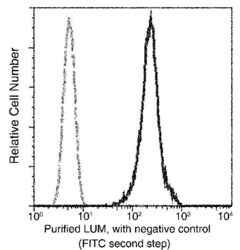Antibody data
- Antibody Data
- Antigen structure
- References [1]
- Comments [0]
- Validations
- Immunocytochemistry [1]
- Flow cytometry [1]
- Other assay [1]
Submit
Validation data
Reference
Comment
Report error
- Product number
- MA5-29402 - Provider product page

- Provider
- Invitrogen Antibodies
- Product name
- LUM Recombinant Rabbit Monoclonal Antibody (077)
- Antibody type
- Monoclonal
- Antigen
- Recombinant full-length protein
- Description
- This product is preservative free. It is recommended to add sodium azide to avoid contamination (final concentration 0.05%-0.1%). Recombinant rabbit monoclonal antibodies are produced using in vitro expression systems. The expression systems are developed by cloning in the specific antibody DNA sequences from immunoreactive rabbits. Then, individual clones are screened to select the best candidates for production. The advantages of using recombinant rabbit monoclonal antibodies include: better specificity and sensitivity, lot-to-lot consistency, animal origin-free formulations, and broader immunoreactivity to diverse targets due to larger rabbit immune repertoire. This antibody has specificity for Human Lumican.
- Reactivity
- Human
- Host
- Rabbit
- Isotype
- IgG
- Antibody clone number
- 77
- Vial size
- 100 µL
- Concentration
- 1 mg/mL
- Storage
- Store at 4°C short term. For long term storage, store at -20°C, avoiding freeze/thaw cycles.
Submitted references Single-cell atlas of early human brain development highlights heterogeneity of human neuroepithelial cells and early radial glia.
Eze UC, Bhaduri A, Haeussler M, Nowakowski TJ, Kriegstein AR
Nature neuroscience 2021 Apr;24(4):584-594
Nature neuroscience 2021 Apr;24(4):584-594
No comments: Submit comment
Supportive validation
- Submitted by
- Invitrogen Antibodies (provider)
- Main image

- Experimental details
- Immunofluorescence staining of Human LUM in Hela cells. Cells were fixed with 4% PFA, permeabilzed with 0.3% Triton X-100 in PBS, blocked with 10% serum, and incubated with LUM Recombinant Rabbit Monoclonal Antibody (77) (Product # MA5-29402, 1:60) at 4°C overnight. Then cells were stained with the Alexa Fluor® 488-conjugated Goat Anti-rabbit IgG secondary antibody (green) and counterstained with DAPI (blue). Positive staining was localized to cytoplasm.
Supportive validation
- Submitted by
- Invitrogen Antibodies (provider)
- Main image

- Experimental details
- Flow cytometric analysis of Human LUM expression on HeLa cells . The cells were treated according to manufacturer’s manual, stained with LUM Recombinant Rabbit Monoclonal Antibody (77) (Product # MA5-29402), then a FITC-conjugated Secondary antibody. The fluorescence histograms were derived from gated events with the forward and side light-scatter characteristics of intact cells.
Supportive validation
- Submitted by
- Invitrogen Antibodies (provider)
- Main image

- Experimental details
- Fig. 3 scRNA-seq identifies early mesenchymal cell population. a , LUM and ALX1 are mesenchymal cell type and early sample markers. In both progenitor and cortex clusterings, LUM marks a separate population of cells, as shown by the feature plot on the left. LUM expression is highly specific to the mesenchymal cell type and is enriched in early samples. ALX1 expression is highly correlated to LUM as shown in the right feature plot, and is similarly enriched in early, mesenchymal populations. b , LUM is widely expressed early and diminishes later. Immunostaining for LUM (cyan) shows prevalent expression in and between progenitors marked by SOX2 (red) at CS16, but this expression dissipates by CS22. However, expression of LUM does not begin until week 7 in the H1 organoid. Scale bars are 50 muM. c , ALX1 is sparsely expressed early and diminishes later. Immunostaining for ALX1 (cyan) shows sparse expression in PAX6 (green) positive cells; it disappears from the cortex but is expressed in surrounding brain structures at CS22. ALX1 expression does not begin until week 10 in the 13,234 cerebral organoids. For all panels, each sample was immunostained once. Scale bars, 50 muM.
 Explore
Explore Validate
Validate Learn
Learn Immunocytochemistry
Immunocytochemistry